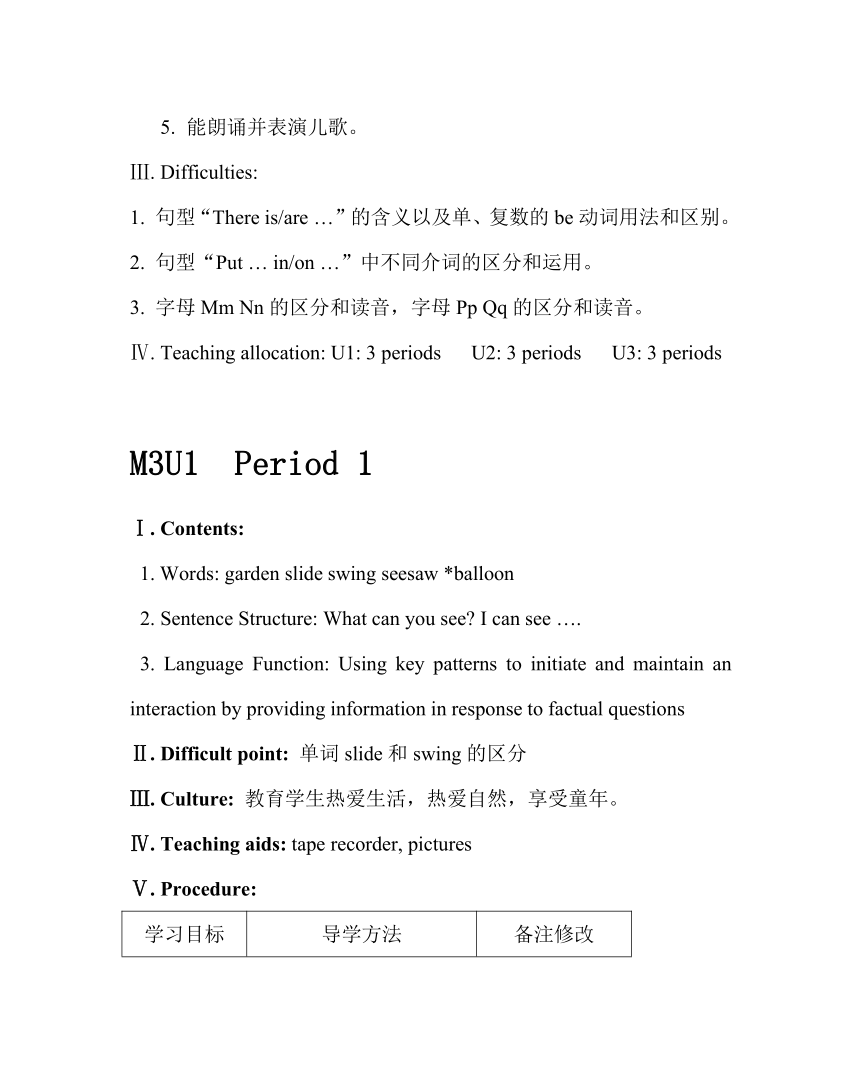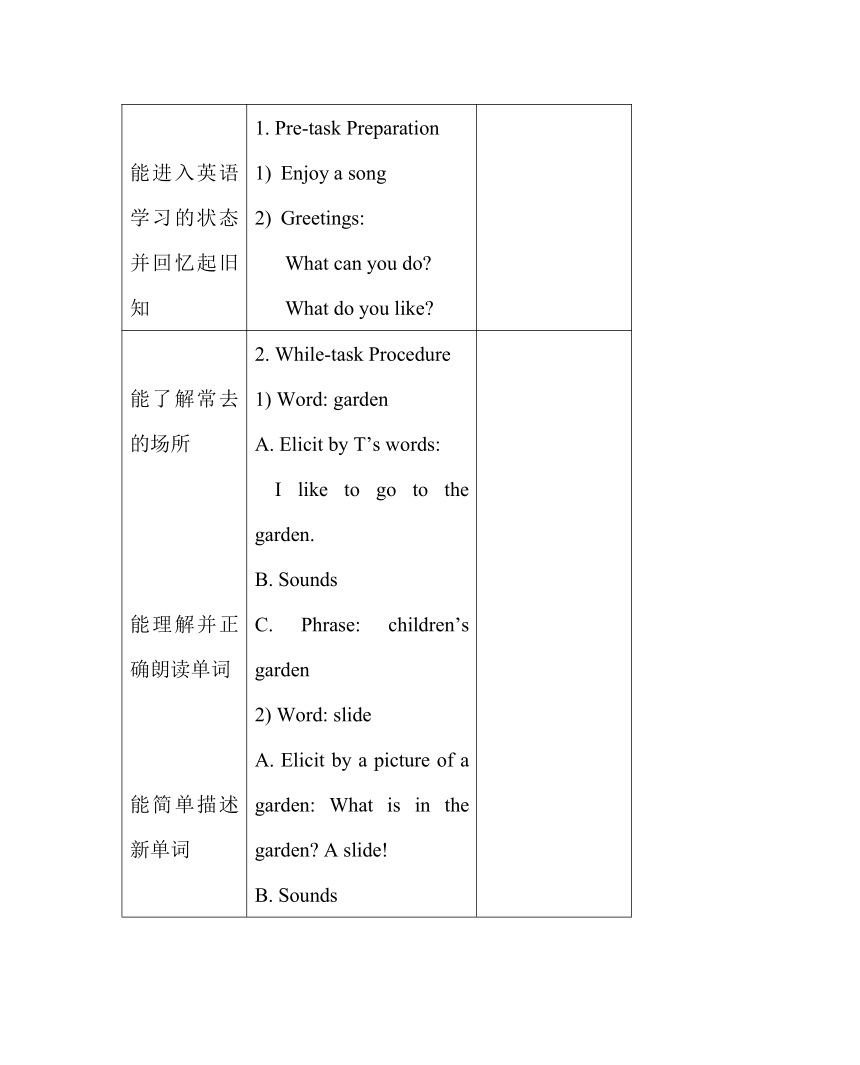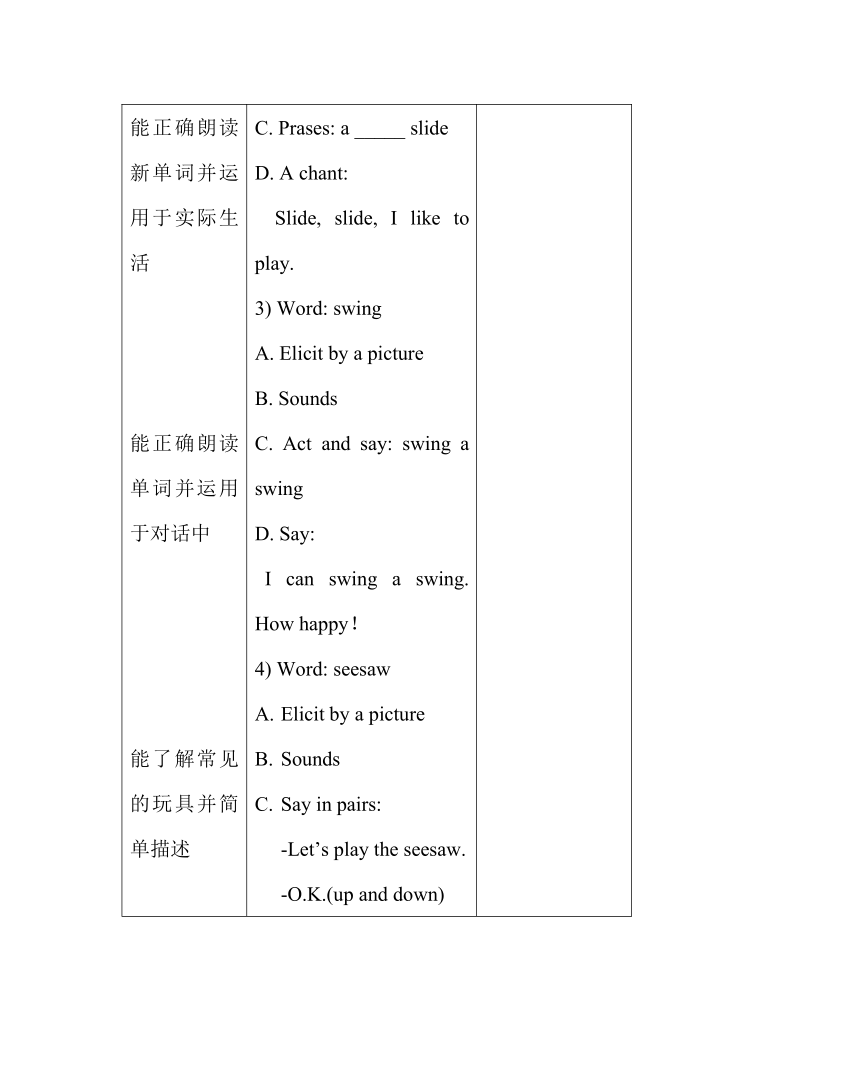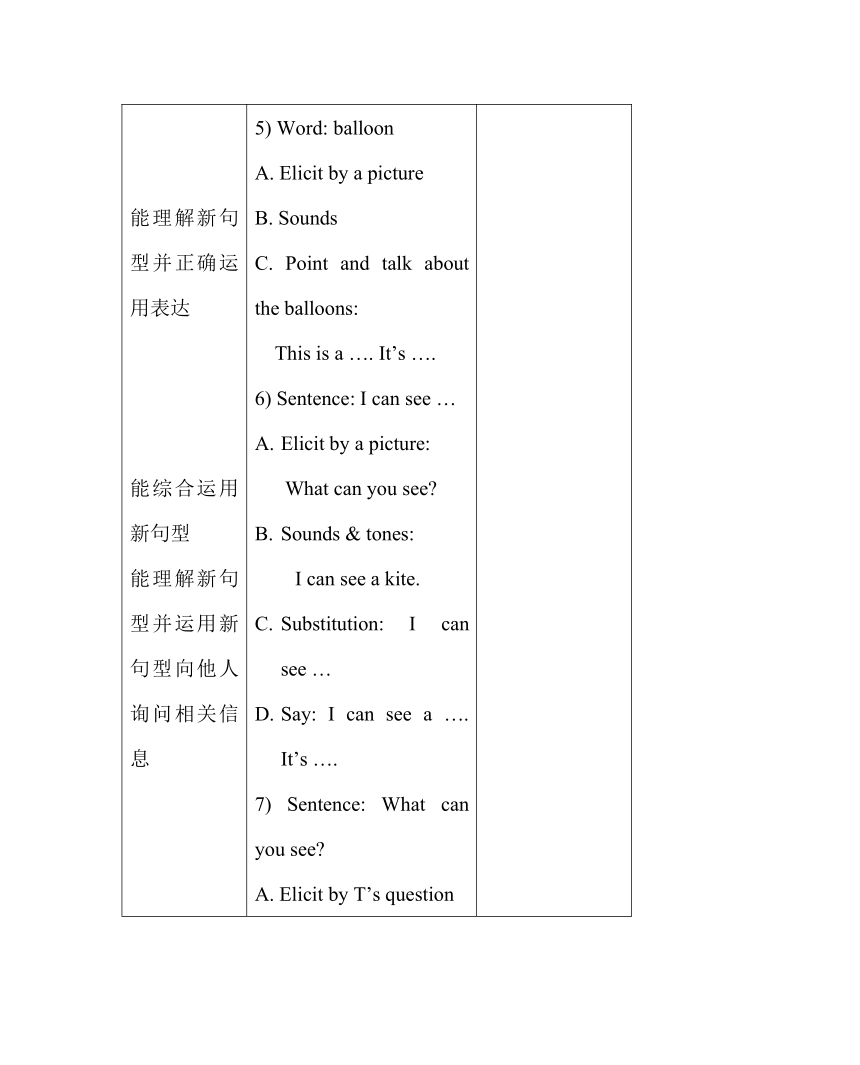Unit 7 In the playground 教案
文档属性
| 名称 | Unit 7 In the playground 教案 |  | |
| 格式 | zip | ||
| 文件大小 | 121.2KB | ||
| 资源类型 | 教案 | ||
| 版本资源 | 牛津深圳版 | ||
| 科目 | 英语 | ||
| 更新时间 | 2017-12-09 19:00:44 | ||
图片预览





文档简介
Module3
Places
and
activities
Ⅰ.
Teaching
contents:
1.
Letters:
Mm
Nn
Oo
Pp
Qq
Rr
2.
Words:
slide,
swing,
seesaw,
bag,
box,
desk,
chair,
bowl,
plate,
spoon,
chopsticks
3.
Sentences:
What
can
you
see
I
can
see
…
Put
…
in/on
…
Look
at
…
How
many
…
There
is/are
…
3.
Songs
and
rhymes:
Listen
and
enjoy
Ⅱ.
Key
points:
能听、说、认读单词slide
swing
seesaw
bag
box
desk
chair
bowl
plate
spoon
chopsticks。
能在真实情景中运用句型
“What
can
you
see .”询问他人看到的情况并能运用句型“I
can
see
….”作出真实的应答,认读句型。
能理解并正确运用句型“Put
…
in/on
…”向他人发出口令,能理解不同位置的表达方法,认读句型。
能理解并运用句型“There
is/are
…”表达相关信息,认读句型。
能朗诵并表演儿歌。
Ⅲ.
Difficulties:
1.
句型“There
is/are
…”的含义以及单、复数的be动词用法和区别。
2.
句型“Put
…
in/on
…”中不同介词的区分和运用。
3.
字母Mm
Nn的区分和读音,字母Pp
Qq的区分和读音。
Ⅳ.
Teaching
allocation:
U1:
3
periods
U2:
3
periods
U3:
3
periods
M3U1
Period
1
Ⅰ.
Contents:
1.
Words:
garden
slide
swing
seesaw
balloon
2.
Sentence
Structure:
What
can
you
see
I
can
see
….
3.
Language
Function:
Using
key
patterns
to
initiate
and
maintain
an
interaction
by
providing
information
in
response
to
factual
questions
Ⅱ.
Difficult
point:
单词slide和swing的区分
Ⅲ.
Culture:
教育学生热爱生活,热爱自然,享受童年。
Ⅳ.
Teaching
aids:
tape
recorder,
pictures
Ⅴ.
Procedure:
学习目标
导学方法
备注修改
能进入英语学习的状态并回忆起旧知
1.
Pre-task
PreparationEnjoy
a
songGreetings:What
can
you
do
What
do
you
like
能了解常去的场所能理解并正确朗读单词能简单描述新单词能正确朗读新单词并运用于实际生活能正确朗读单词并运用于对话中能了解常见的玩具并简单描述能理解新句型并正确运用表达能综合运用新句型能理解新句型并运用新句型向他人询问相关信息能综合运用新旧知识,实现语言的积累
2.
While-task
Procedure1)
Word:
gardenA.
Elicit
by
T’s
words:
I
like
to
go
to
the
garden.B.
SoundsC.
Phrase:
children’s
garden2)
Word:
slideA.
Elicit
by
a
picture
of
a
garden:
What
is
in
the
garden
A
slide!B.
SoundsC.
Prases:
a
_____
slideD.
A
chant:
Slide,
slide,
I
like
to
play.3)
Word:
swingA.
Elicit
by
a
pictureB.
SoundsC.
Act
and
say:
swing
a
swingD.
Say:
I
can
swing
a
swing.
How
happy!4)
Word:
seesawElicit
by
a
pictureSoundsSay
in
pairs:-Let’s
play
the
seesaw.-O.K.(up
and
down)5)
Word:
balloonA.
Elicit
by
a
pictureB.
SoundsC.
Point
and
talk
about
the
balloons:
This
is
a
….
It’s
….6)
Sentence:
I
can
see
…Elicit
by
a
picture:
What
can
you
see Sounds
&
tones:
I
can
see
a
kite.Substitution:
I
can
see
…Say:
I
can
see
a
….
It’s
….7)
Sentence:
What
can
you
see A.
Elicit
by
T’s
questionB.
Sounds
&
tonesC.
Point
and
say:
-What
can
you
see
-I
can
see
…D.
Pair
work:
Face
and
back
-What
can
you
see
-I
can
see
….
-What
colour
is
it
-It’s
….
能复习巩固新单词能综合运用新内容进行初步交流能进一步巩固新知识,课后继续交流
3.
Post-task
Activities1)
Game:
What
is
missing
in
the
garden 2)
Play
a
game:
Running
dictation3)
HomeworkA.
Listen
and
read
P26-27B.
Ask
your
friends
“What
can
you
see ”
in
the
bag,
pencil-box,
park
or
zoo
M3U1
Period
2
Ⅰ.
Contents:
1.
Letters:
Mm
Nn
2.
Words:
mouse
man
net
3.
Sentence
Structure:
You/They
like
to
…
…
has
…
4.
Language
Function:
Using
the
struture
to
describe
others’
hobby
5.
Listen
and
enjoy
the
rhyme
Ⅱ.
Difficult
point:
非第三人称的区分和运用
Ⅲ.
Culture:
教育学生热爱生活,热爱自然,享受童年。
Ⅳ.
Teaching
aids:
tape
recorder,
pictures
Ⅴ.
Procedure:
学习目标
导学方法
备注修改
能回忆起旧知识
1.
Pre-task
Preparation1)
Quick
responds:
What
can
you
see 2)
Talk
about
the
toy
you
like
能理解并正确表达新句型能理解并正确表达新句型能理解并正确朗读儿歌能认读字母及相关的单词能认读字母及相关的单词能理解新句型并正确表达能朗读并表演儿歌
2.
While-task
Procedure1)
Sentence:
You
like
to
…A.
Elicit
by
T’s
words:
You
like
to
play.B.
Sounds
&
tonesC.
Substitution:
You
like
to
…2)
Sentence:
They
like
to
…A.
Elicit
by
T’s
words:
Look
at
…
They
like
to
play.B.
Sounds
&
tonesC.
Substitution:
They
like
to
…3)
Learn
the
rhyme
on
P28A.
Elicit
by
the
tapeB.
Read
after
the
tapeC.
Read
and
act
the
rhyme4)
Letter:
Mm
&
manA.
Elicit
by
a
pictureB.
Sounds:
MmC.
Elicit
by
T’s
word:
M
is
for
man.D.
Sounds:
man5)
Letter:
Nn
&
netA.
Elicit
by
T’s
words:
The
man
has
a
net.B.
Sounds:
netC.
Elicit
by
T’s
word:
N
for
net.D.
Sounds:
Nn6)
Sentence:
…
has
…A.
Elicit
by
a
question:
Who
has
a
net B.
Sounds
&
tones:
The
man
has
a
net.C.
Substitution:
The
man
has
a
…
…
has
…7)
Learn
the
rhyme
on
P29A.
Elicit
by
the
tapeB.
Listen
and
read
能复习巩固新知能正确书写字母能进一步巩固新知识
3.
Post-task
Activities1)
Listen
and
act
the
rhyme2)
Write
the
letters3)
HomeworkA.
Listen
and
read
P28-29B.
Act
the
rhyme
for
your
parents
NOTES:
能正确朗读新单词并运用于实际生活
能正确朗读单词并运用于对话中
能朗读并表演儿歌
Places
and
activities
Ⅰ.
Teaching
contents:
1.
Letters:
Mm
Nn
Oo
Pp
Rr
2.
Words:
slide,
swing,
seesaw,
bag,
box,
desk,
chair,
bowl,
plate,
spoon,
chopsticks
3.
Sentences:
What
can
you
see
I
can
see
…
Put
…
in/on
…
Look
at
…
How
many
…
There
is/are
…
3.
Songs
and
rhymes:
Listen
and
enjoy
Ⅱ.
Key
points:
能听、说、认读单词slide
swing
seesaw
bag
box
desk
chair
bowl
plate
spoon
chopsticks。
能在真实情景中运用句型
“What
can
you
see .”询问他人看到的情况并能运用句型“I
can
see
….”作出真实的应答,认读句型。
能理解并正确运用句型“Put
…
in/on
…”向他人发出口令,能理解不同位置的表达方法,认读句型。
能理解并运用句型“There
is/are
…”表达相关信息,认读句型。
能朗诵并表演儿歌。
Ⅲ.
Difficulties:
1.
句型“There
is/are
…”的含义以及单、复数的be动词用法和区别。
2.
句型“Put
…
in/on
…”中不同介词的区分和运用。
3.
字母Mm
Nn的区分和读音,字母Pp
Qq的区分和读音。
Ⅳ.
Teaching
allocation:
U1:
3
periods
U2:
3
periods
U3:
3
periods
M3U1
Period
1
Ⅰ.
Contents:
1.
Words:
garden
slide
swing
seesaw
balloon
2.
Sentence
Structure:
What
can
you
see
I
can
see
….
3.
Language
Function:
Using
key
patterns
to
initiate
and
maintain
an
interaction
by
providing
information
in
response
to
factual
questions
Ⅱ.
Difficult
point:
单词slide和swing的区分
Ⅲ.
Culture:
教育学生热爱生活,热爱自然,享受童年。
Ⅳ.
Teaching
aids:
tape
recorder,
pictures
Ⅴ.
Procedure:
学习目标
导学方法
备注修改
能进入英语学习的状态并回忆起旧知
1.
Pre-task
PreparationEnjoy
a
songGreetings:What
can
you
do
What
do
you
like
能了解常去的场所能理解并正确朗读单词能简单描述新单词能正确朗读新单词并运用于实际生活能正确朗读单词并运用于对话中能了解常见的玩具并简单描述能理解新句型并正确运用表达能综合运用新句型能理解新句型并运用新句型向他人询问相关信息能综合运用新旧知识,实现语言的积累
2.
While-task
Procedure1)
Word:
gardenA.
Elicit
by
T’s
words:
I
like
to
go
to
the
garden.B.
SoundsC.
Phrase:
children’s
garden2)
Word:
slideA.
Elicit
by
a
picture
of
a
garden:
What
is
in
the
garden
A
slide!B.
SoundsC.
Prases:
a
_____
slideD.
A
chant:
Slide,
slide,
I
like
to
play.3)
Word:
swingA.
Elicit
by
a
pictureB.
SoundsC.
Act
and
say:
swing
a
swingD.
Say:
I
can
swing
a
swing.
How
happy!4)
Word:
seesawElicit
by
a
pictureSoundsSay
in
pairs:-Let’s
play
the
seesaw.-O.K.(up
and
down)5)
Word:
balloonA.
Elicit
by
a
pictureB.
SoundsC.
Point
and
talk
about
the
balloons:
This
is
a
….
It’s
….6)
Sentence:
I
can
see
…Elicit
by
a
picture:
What
can
you
see Sounds
&
tones:
I
can
see
a
kite.Substitution:
I
can
see
…Say:
I
can
see
a
….
It’s
….7)
Sentence:
What
can
you
see A.
Elicit
by
T’s
questionB.
Sounds
&
tonesC.
Point
and
say:
-What
can
you
see
-I
can
see
…D.
Pair
work:
Face
and
back
-What
can
you
see
-I
can
see
….
-What
colour
is
it
-It’s
….
能复习巩固新单词能综合运用新内容进行初步交流能进一步巩固新知识,课后继续交流
3.
Post-task
Activities1)
Game:
What
is
missing
in
the
garden 2)
Play
a
game:
Running
dictation3)
HomeworkA.
Listen
and
read
P26-27B.
Ask
your
friends
“What
can
you
see ”
in
the
bag,
pencil-box,
park
or
zoo
M3U1
Period
2
Ⅰ.
Contents:
1.
Letters:
Mm
Nn
2.
Words:
mouse
man
net
3.
Sentence
Structure:
You/They
like
to
…
…
has
…
4.
Language
Function:
Using
the
struture
to
describe
others’
hobby
5.
Listen
and
enjoy
the
rhyme
Ⅱ.
Difficult
point:
非第三人称的区分和运用
Ⅲ.
Culture:
教育学生热爱生活,热爱自然,享受童年。
Ⅳ.
Teaching
aids:
tape
recorder,
pictures
Ⅴ.
Procedure:
学习目标
导学方法
备注修改
能回忆起旧知识
1.
Pre-task
Preparation1)
Quick
responds:
What
can
you
see 2)
Talk
about
the
toy
you
like
能理解并正确表达新句型能理解并正确表达新句型能理解并正确朗读儿歌能认读字母及相关的单词能认读字母及相关的单词能理解新句型并正确表达能朗读并表演儿歌
2.
While-task
Procedure1)
Sentence:
You
like
to
…A.
Elicit
by
T’s
words:
You
like
to
play.B.
Sounds
&
tonesC.
Substitution:
You
like
to
…2)
Sentence:
They
like
to
…A.
Elicit
by
T’s
words:
Look
at
…
They
like
to
play.B.
Sounds
&
tonesC.
Substitution:
They
like
to
…3)
Learn
the
rhyme
on
P28A.
Elicit
by
the
tapeB.
Read
after
the
tapeC.
Read
and
act
the
rhyme4)
Letter:
Mm
&
manA.
Elicit
by
a
pictureB.
Sounds:
MmC.
Elicit
by
T’s
word:
M
is
for
man.D.
Sounds:
man5)
Letter:
Nn
&
netA.
Elicit
by
T’s
words:
The
man
has
a
net.B.
Sounds:
netC.
Elicit
by
T’s
word:
N
for
net.D.
Sounds:
Nn6)
Sentence:
…
has
…A.
Elicit
by
a
question:
Who
has
a
net B.
Sounds
&
tones:
The
man
has
a
net.C.
Substitution:
The
man
has
a
…
…
has
…7)
Learn
the
rhyme
on
P29A.
Elicit
by
the
tapeB.
Listen
and
read
能复习巩固新知能正确书写字母能进一步巩固新知识
3.
Post-task
Activities1)
Listen
and
act
the
rhyme2)
Write
the
letters3)
HomeworkA.
Listen
and
read
P28-29B.
Act
the
rhyme
for
your
parents
NOTES:
能正确朗读新单词并运用于实际生活
能正确朗读单词并运用于对话中
能朗读并表演儿歌
同课章节目录
- Module 1 Getting to know you
- Unit 1 Good morning
- Unit 2 I'm Danny
- Unit 3 Are you Alice?
- Revision 1
- Module 2 My family, my friends and me
- Unit 4 Can you swim?
- Unit 5 That's my family
- Unit 6 My hair is short
- Revision 2
- Module 3 Places and activities
- Unit 7 In the playground
- Unit 8 In my room
- Unit 9 Dinner is ready
- Revision 3
- Module 4 The world around us
- Unit 10 In the sky
- Unit 11 In the forest
- Unit 12 In the street
- Revision 4
